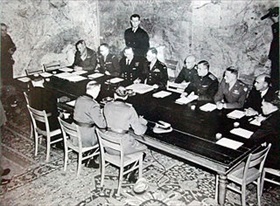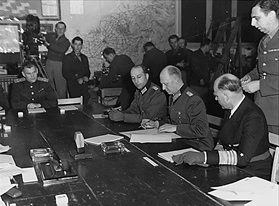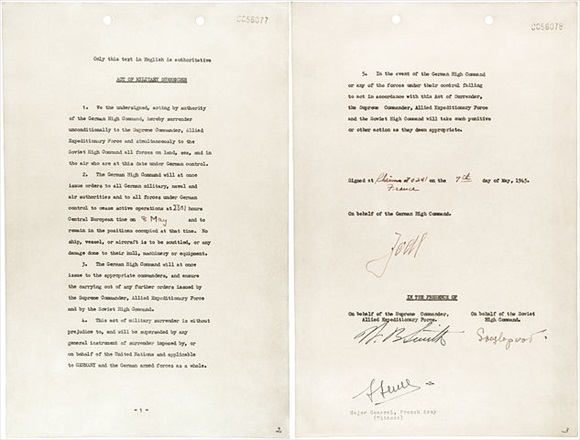GERMANS SIGN UNCONDITIONAL SURRENDER
Reims, France • May 7, 1945
Five days after the suicide of Adolf Hitler on April 30, 1945, Adm. Hans-Georg von Friedeburg, an emissary from Grand Admiral Karl Doenitz, arrived in the French cathedral town of Reims, headquarters of Gen. Dwight D. Eisenhower, Supreme Commander Allied Expeditionary Force, looking pale and tired. For the second time in less than a week Friedeburg was tasked with opening surrender negotiations on behalf of Doenitz, Reich President of the rump Nazi state centered on Flensburg, close to the Danish border in Northern Germany. With Eisenhower’s concurrence the first surrender negotiations with the Friedeburg delegation occurred on May 3–4 near Germany’s Lueneberg Heath in the presence of British Field Marshal Bernard Law Montgomery, commander the Allies’ 21st Army Group. The partial surrender applied only to German armed forces in Holland, Northwest Germany, and Denmark.
In Reims Friedeburg began, Eisenhower remarked later, “playing for time” so that the Germans could move as many of their men and pieces of equipment as possible behind Anglo-American lines and away from Soviet lines in Eastern Europe. Indeed, as many as 210,000 German troops had streamed into British and American lines in the last couple of days. Friedeburg was brought up short when Eisenhower’s representative and chief of staff, Gen. Walter Bedell Smith, made it plain that the Allies would only accept unconditional surrender on all fronts. Doenitz complied with the demand, empowering Col. Gen. Alfred Jodl, Chief of the Operations Staff of the Armed Forces High Command (Oberkommando der Wehrmacht, or OKW), to sign on this date, May 7, 1945, in Reims formal papers of surrender of all German land, sea, and air forces in Europe. After affixing his signature, 54‑year-old Jodl addressed his audience, saying: “At this hour, we [he meant the German nation and German Armed Forces] can only hope that the victors will be generous.” Eisenhower coolly responded that “the German Supreme Commander will appear for the surrender to the Russians at the time and the place that the Russian High Command will designate.”
Following the signing ceremony Eisenhower informed the Allied War Office in London: “The mission of this Allied Force was fulfilled at 0241, local time, May 7, 1945.” The next day in Berlin, May 8, 1945, Field Marshal Wilhelm Keitel, head of the entire OKW, along with representatives of the German Navy and Air Force, signed a second unconditional surrender document in Berlin-Karlshorst. Present were Soviet Marshal Georgy Zhukov, signing on behalf of the Supreme Command of the Red Army; Deputy Supreme Commander Allied Expeditionary Force British Air Chief Marshal Arthur Tedder, signing as Gen. Eisenhower’s representative; and French Gen. Jean de Lattre de Tassigny, who signed as a witness. When Keitel saw the French delegation, he exclaimed, “What? The French too?”
Because Doenitz’s and Jodl’s communication links with and even authority over German troops in the field were challenging, even dubious, at this juncture, some fighting continued. Certain tank regiments, fanatical Waffen-SS units (which had the most to lose from the victors), and Hitler Youth simply refused orders to lay down their arms. But the fact remained, the war in Europe was officially over after nearly 5‑1/2 years and after the deaths of between 65 and 85 million combatants and noncombatants. (The higher figure represents the millions who died from war-related disease and famine.) The German Reich Adolf Hitler had vowed would endure a thousand years had lasted a pitiful and extremely painful dozen.
![]()
The German Instrument of Surrender, May 7, 1945
 |  |
Left: In the early hours of Monday, May 7, 1945, Col. Gen. Alfred Jodl, Chief of the Operations Staff of the Armed Forces High Command, along with two other German officers, gathered in the 30-ft by 30-ft map room of the headquarters (a former school building) of Gen. Dwight D. Eisenhower, Supreme Allied Commander in Europe. The three German officers (backs to the camera) were flanked on three sides of the large table by U.S., British, French, and Soviet officers, who watched Jodl sign the German Instrument of Surrender, which ended World War II in Europe. Also watching were 17 reporters from the news pool. One microphone and one film camera recorded the surrender.
![]()
Right: A strong opponent of general surrender, Jodl, Chief of Staff in Reich President Adm. Karl Doenitz’s government (successor regime to Hitler’s), signs the document of unconditional surrender as ordered by Doenitz minutes before in a radio message. On Jodl’s left is Adm. Hans-Georg von Friedeburg of the German Navy, and on the right is Jodl’s aide and translator, Maj. Wilhelm Oxenius. Friedeburg, who was in Berlin the next day to sign the second German Instrument of Surrender at Soviet military headquarters, committed suicide on May 23, 1945, when a British team arrived at Doenitz’s headquarters in Flensburg, Northern Germany, and arrested members of his Nazi government. Jodl, like OKW chief Field Marshal Wilhelm Keitel, taken into custody on May 11, was tried by the postwar International Military Tribunal at Nuremberg and sentenced to death. Jodl and Keitel were hanged as war criminals on October 16, 1946.
 |
Above: Jodl signed the “Act of Military Surrender” in Reims, France, at 2:39 a.m., the first of two surrender documents signed by the German military. At the same time Jodl signed Eisenhower’s copy of the surrender document, he signed three more, one each for Great Britain, the Soviet Union, and France. Over Jodl’s signature are the words, “On behalf of the German High Command,” not (and this became significant later) as a representative of the legal head of state, Reich President Doenitz. (The Allies never considered Hitler’s vestigial Nazi regime at Flensburg a “government,” but merely a remnant of the German military high command.) Under Jodl’s signature in capital letters are the words, “IN THE PRESENCE OF.” Then appeared the signatures of Gen. Walter Bedell Smith, Eisenhower’s chief of staff, who signed on behalf of the Supreme Commander Allied Expeditionary Force; Ivan Sousloparov, who signed on behalf of the Soviet High Command; and François Sevez, a Major General in the French Army, who signed as witness.
Contemporary Newsreel Account of Repeat German Surrender Ceremony the Next Day in Berlin, May 8, 1945, VE Day
![]()

 History buffs, there is good news! The Daily Chronicles of World War II is now available as an ebook for $4.99 on Amazon.com. Containing a year’s worth of dated entries from this website, the ebook brings the story of this tumultuous era to life in a compelling, authoritative, and succinct manner. Featuring inventive navigation aids, the ebook enables readers to instantly move forward or backward by month and date to different dated entries. Simple and elegant! Click
History buffs, there is good news! The Daily Chronicles of World War II is now available as an ebook for $4.99 on Amazon.com. Containing a year’s worth of dated entries from this website, the ebook brings the story of this tumultuous era to life in a compelling, authoritative, and succinct manner. Featuring inventive navigation aids, the ebook enables readers to instantly move forward or backward by month and date to different dated entries. Simple and elegant! Click 











